Architectonic subdivisions of neocortex in the Galago (Otolemur garnetti)
- PMID: 20201060
- PMCID: PMC3066689
- DOI: 10.1002/ar.21109
Architectonic subdivisions of neocortex in the Galago (Otolemur garnetti)
Abstract
In the present study, galago brains were sectioned in the coronal, sagittal, or horizontal planes, and sections were processed with several different histochemical and immunohistochemical procedures to reveal the architectonic characteristics of the various cortical areas. The histochemical methods used included the traditional Nissl, cytochrome oxidase, and myelin stains, as well as a zinc stain, which reveals free ionic zinc in the axon terminals of neurons. Immunohistochemical methods include parvalbumin (PV) and calbindin (CB), both calcium-binding proteins, and the vesicle glutamate transporter 2 (VGluT2). These different procedures revealed similar boundaries between areas, which suggests that functionally relevant borders were being detected. These results allowed a more precise demarcation of previously identified areas. As thalamocortical terminations lack free ionic zinc, primary cortical areas were most clearly revealed by the zinc stain, because of the poor zinc staining of layer 4. Area 17 was especially prominent, as the broad layer 4 was nearly free of zinc stain. However, this feature was less pronounced in the primary auditory and somatosensory cortex. As VGluT2 is expressed in thalamocortical terminations, layer 4 of primary sensory areas was darkly stained for VGluT2. Primary motor cortex had reduced VGluT2 staining, and increased zinc-enriched terminations in the poorly developed granular layer 4 compared to the adjacent primary somatosensory area. The middle temporal visual (MT) showed increased PV and VGluT2 staining compared to the surrounding cortical areas. The resulting architectonic maps of cortical areas in galagos can usefully guide future studies of cortical organizations and functions.
Figures

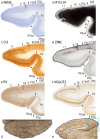






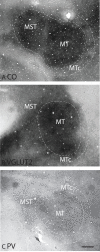

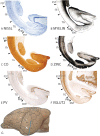


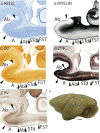
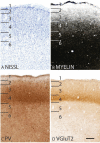
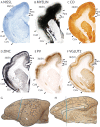
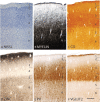

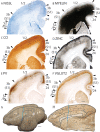




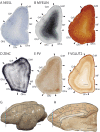
Similar articles
-
Architectonic subdivisions of neocortex in the tree shrew (Tupaia belangeri).Anat Rec (Hoboken). 2009 Jul;292(7):994-1027. doi: 10.1002/ar.20916. Anat Rec (Hoboken). 2009. PMID: 19462403 Free PMC article.
-
Architectonic subdivisions of neocortex in the gray squirrel (Sciurus carolinensis).Anat Rec (Hoboken). 2008 Oct;291(10):1301-33. doi: 10.1002/ar.20758. Anat Rec (Hoboken). 2008. PMID: 18780299 Free PMC article.
-
An architectonic study of the neocortex of the short-tailed opossum (Monodelphis domestica).Brain Behav Evol. 2009;73(3):206-28. doi: 10.1159/000225381. Epub 2009 Jun 16. Brain Behav Evol. 2009. PMID: 19546531 Free PMC article.
-
Calcium-binding proteins in the human developing brain.Adv Anat Embryol Cell Biol. 2002;165:III-IX, 1-92. Adv Anat Embryol Cell Biol. 2002. PMID: 12236093 Review.
-
Cortical connections of MT in four species of primates: areal, modular, and retinotopic patterns.Vis Neurosci. 1990 Aug;5(2):165-204. doi: 10.1017/s0952523800000213. Vis Neurosci. 1990. PMID: 2278944 Review.
Cited by
-
The evolution of brains from early mammals to humans.Wiley Interdiscip Rev Cogn Sci. 2013 Jan;4(1):33-45. doi: 10.1002/wcs.1206. Epub 2012 Nov 8. Wiley Interdiscip Rev Cogn Sci. 2013. PMID: 23529256 Free PMC article. Review.
-
Thalamic connections of the caudal part of the posterior parietal cortex differ from the rostral part in galagos (Otolemur garnettii).J Comp Neurol. 2023 Dec;531(17):1752-1771. doi: 10.1002/cne.25537. Epub 2023 Sep 13. J Comp Neurol. 2023. PMID: 37702312 Free PMC article.
-
Movement representations in motor, somatosensory, and posterior parietal cortex of the greater galago.Cereb Cortex. 2025 Aug 1;35(8):bhaf195. doi: 10.1093/cercor/bhaf195. Cereb Cortex. 2025. PMID: 40838806 Free PMC article.
-
Cortical connections to single digit representations in area 3b of somatosensory cortex in squirrel monkeys and prosimian galagos.J Comp Neurol. 2013 Nov;521(16):3768-90. doi: 10.1002/cne.23377. J Comp Neurol. 2013. PMID: 23749740 Free PMC article.
-
The postnatal development of MT, V1, LGN, pulvinar and SC in prosimian galagos (Otolemur garnettii).J Comp Neurol. 2020 Dec 1;528(17):3075-3094. doi: 10.1002/cne.24885. Epub 2020 Feb 24. J Comp Neurol. 2020. PMID: 32067231 Free PMC article.
References
-
- Allman JM, Kaas JH. Representation of the visual field in striate and adjoining cortex of the owl monkey (Aotus trivirgatus) Brain Res. 1971a;35(1):89–106. - PubMed
-
- Allman JM, Kaas JH. A representation of the visual field in the caudal third of the middle tempral gyrus of the owl monkey (Aotus trivirgatus) Brain Res. 1971b;31(1):85–105. - PubMed
-
- Allman JM, Kaas JH. The organization of the second visual area (V II) in the owl monkey: a second order transformation of the visual hemifield. Brain Res. 1974;76(2):247–265. - PubMed
-
- Allman JM, Kaas JH. The dorsomedial cortical visual area: a third tier area in the occipital lobe of the owl monkey (Aotus trivirgatus) Brain Res. 1975;100(3):473–487. - PubMed
-
- Allman JM, Campbell CB, McGuinness E. The dorsal third tier area in Galago senegalensis. Brain Res. 1979;179(2):355–361. - PubMed
Publication types
MeSH terms
Substances
Grants and funding
LinkOut - more resources
Full Text Sources
Research Materials

